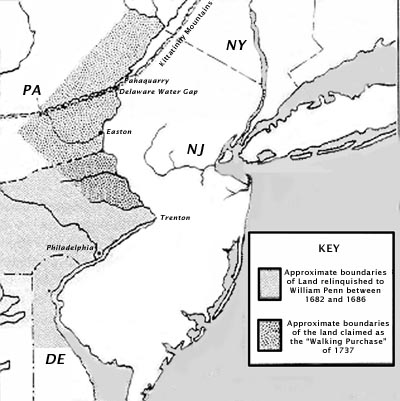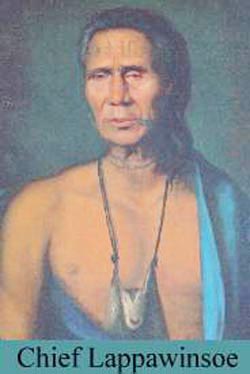The Walking Purchase
In Lenape history there is the story of the “Walking Purchase” which took place in 1737. William Penn had always dealt fairly with the Lenape, but after he returned to England his sons and other agents began to sell land to pay their creditors, and these were lands which were still owned by the Lenape.
 In order to convince the Lenape to part with the land, the Penns falsely represented an old, incomplete, unsigned draft of a deed as a legal contract. They told the Lenape that their ancestors some fifty years before had signed this document which stated that the land to be deeded to the Penns was as much as could be covered in a day-and-a-half’s walk.
In order to convince the Lenape to part with the land, the Penns falsely represented an old, incomplete, unsigned draft of a deed as a legal contract. They told the Lenape that their ancestors some fifty years before had signed this document which stated that the land to be deeded to the Penns was as much as could be covered in a day-and-a-half’s walk.
Believing that their forefathers had made such an agreement the Lenape leaders agreed to let the Penns have this area walked off. They thought the whites would take a leisurely walk down an Indian path along the Delaware River. Instead, the Penns hired three of the fastest runners, and had a straight path cleared. Only one of the “walkers” was able to complete the “walk,” but he went fifty-five miles.
And so by means of a false deed, and use of runners, the Penns acquired 1200 square miles of Lenape land in Pennsylvania, an area about the size of Rhode Island! The Lenape people complained about the way the “walk” had been done. Lenape chief Lappawinsoe expressed the frustration and dissatisfaction of the Lenape when he said:
 [the white runners] should have walkt along by the River Delaware or the next Indian path to it… should have walkt for a few Miles and then have sat down and smoakt a Pipe, and now and then have shot a Squirrel, and not have kept up the Run, Run all day.
[the white runners] should have walkt along by the River Delaware or the next Indian path to it… should have walkt for a few Miles and then have sat down and smoakt a Pipe, and now and then have shot a Squirrel, and not have kept up the Run, Run all day.
Nonetheless, the Lenape felt honor-bound to fulfill what they thought their ancestors had agreed to, and thus began their movement westward. The Lenape were given place after place. Each time it was promised by the government that it would be their permanent home, only to have to move again. Their trek, which lasted 130 years, finally brought them to what was known as Indian Territory, now Oklahoma.
 D5 Creation
D5 Creation